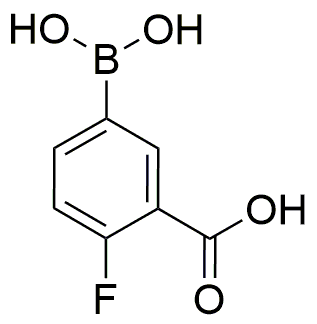3-Carboxy-4-fluorophenylboronic acid is widely utilized in research focused on:
- Pharmaceutical Development: This compound plays a crucial role in the synthesis of various pharmaceuticals, particularly in the development of drugs targeting cancer and diabetes. Its ability to form stable complexes with biomolecules enhances drug efficacy.
- Organic Synthesis: It is a valuable reagent in organic chemistry for the construction of complex molecules. Researchers use it in Suzuki coupling reactions, which are essential for creating biaryl compounds found in many natural products and pharmaceuticals.
- Material Science: This chemical is used in the development of advanced materials, such as polymers and nanomaterials. Its unique properties allow for the modification of material surfaces, improving their performance in various applications.
- Bioconjugation: In biochemistry, it is employed for labeling biomolecules. The boronic acid group can selectively bind to diols, making it useful for creating targeted drug delivery systems and diagnostic tools.
- Environmental Monitoring: This compound can be utilized in the detection of environmental pollutants. Its chemical properties allow for the development of sensors that can identify specific contaminants in water and soil, contributing to environmental protection efforts.
General Information
Properties
Safety and Regulations
Applications
3-Carboxy-4-fluorophenylboronic acid is widely utilized in research focused on:
- Pharmaceutical Development: This compound plays a crucial role in the synthesis of various pharmaceuticals, particularly in the development of drugs targeting cancer and diabetes. Its ability to form stable complexes with biomolecules enhances drug efficacy.
- Organic Synthesis: It is a valuable reagent in organic chemistry for the construction of complex molecules. Researchers use it in Suzuki coupling reactions, which are essential for creating biaryl compounds found in many natural products and pharmaceuticals.
- Material Science: This chemical is used in the development of advanced materials, such as polymers and nanomaterials. Its unique properties allow for the modification of material surfaces, improving their performance in various applications.
- Bioconjugation: In biochemistry, it is employed for labeling biomolecules. The boronic acid group can selectively bind to diols, making it useful for creating targeted drug delivery systems and diagnostic tools.
- Environmental Monitoring: This compound can be utilized in the detection of environmental pollutants. Its chemical properties allow for the development of sensors that can identify specific contaminants in water and soil, contributing to environmental protection efforts.
Documents
Safety Data Sheets (SDS)
The SDS provides comprehensive safety information on handling, storage, and disposal of the product.
Product Specification (PS)
The PS provides a comprehensive breakdown of the product’s properties, including chemical composition, physical state, purity, and storage requirements. It also details acceptable quality ranges and the product's intended applications.
Certificates of Analysis (COA)
Search for Certificates of Analysis (COA) by entering the products Lot Number. Lot and Batch Numbers can be found on a product’s label following the words ‘Lot’ or ‘Batch’.
*Catalog Number
*Lot Number
Certificates Of Origin (COO)
This COO confirms the country where the product was manufactured, and also details the materials and components used in it and whether it is derived from natural, synthetic, or other specific sources. This certificate may be required for customs, trade, and regulatory compliance.
*Catalog Number
*Lot Number
Safety Data Sheets (SDS)
The SDS provides comprehensive safety information on handling, storage, and disposal of the product.
DownloadProduct Specification (PS)
The PS provides a comprehensive breakdown of the product’s properties, including chemical composition, physical state, purity, and storage requirements. It also details acceptable quality ranges and the product's intended applications.
DownloadCertificates of Analysis (COA)
Search for Certificates of Analysis (COA) by entering the products Lot Number. Lot and Batch Numbers can be found on a product’s label following the words ‘Lot’ or ‘Batch’.
*Catalog Number
*Lot Number
Certificates Of Origin (COO)
This COO confirms the country where the product was manufactured, and also details the materials and components used in it and whether it is derived from natural, synthetic, or other specific sources. This certificate may be required for customs, trade, and regulatory compliance.


